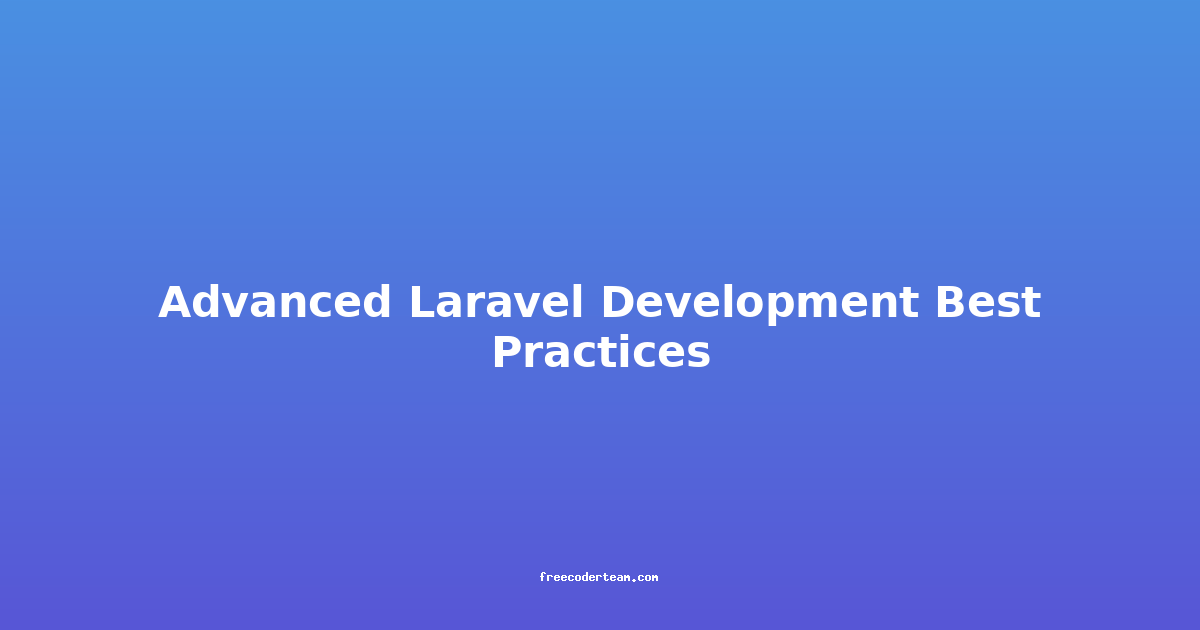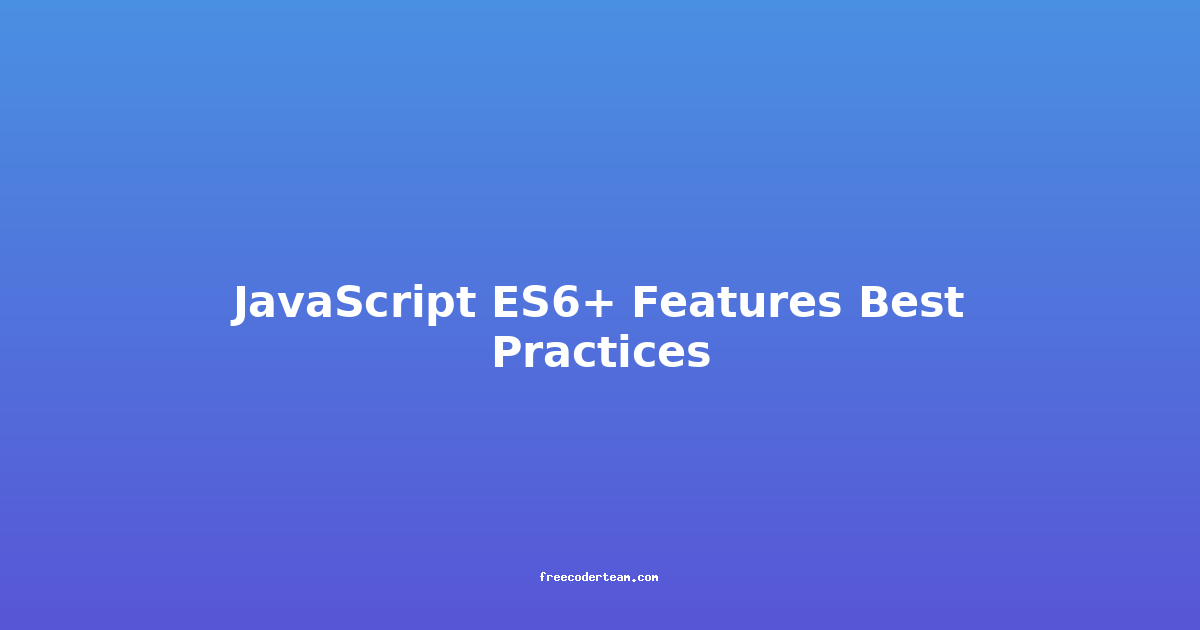Advanced Laravel Development Best Practices
Laravel is a powerful PHP framework that has gained immense popularity among developers due to its elegant syntax, robust features, and developer-friendly ecosystem. However, as applications grow in complexity, adhering to best practices becomes crucial to ensure maintainability, scalability, and performance. In this blog post, we will explore advanced Laravel development best practices, including practical examples and actionable insights to help you build high-quality applications.
Table of Contents
- 1. Modular Architecture
- 2. Dependency Injection and Service Providers
- 3. Advanced Eloquent Query Optimization
- 4. Event-driven Programming
- 5. Testing and Code Quality
- 6. Security Practices
- 7. Performance Optimization
- 8. Conclusion
1. Modular Architecture
1.1. Using Laravel Packages
Laravel packages allow you to encapsulate reusable functionality into standalone modules, making your application more modular and easier to maintain. For example, you can create a package for user authentication or CRM functionality.
Example: Creating a Custom Package
composer create-project --prefer-dist laravel/laravel my-package
Inside the package, you can define controllers, models, and migrations, and publish them using Artisan commands.
// Define a service provider in the package
namespace Acme\Package;
use Illuminate\Support\ServiceProvider;
class AcmeServiceProvider extends ServiceProvider
{
public function boot()
{
$this->loadRoutesFrom(__DIR__ . '/routes/web.php');
$this->loadMigrationsFrom(__DIR__ . '/database/migrations');
}
public function register()
{
// Register package-specific bindings here
}
}
Publishing the Package:
php artisan vendor:publish --provider="Acme\Package\AcmeServiceProvider"
1.2. Feature-based Directory Structure
Organize your application code based on features rather than generic directories like Controllers, Models, etc. This approach helps in keeping related code together and improves readability.
Example: Feature-based Directory
app/
├── Features/
│ ├── Users/
│ │ ├── Controllers/
│ │ ├── Models/
│ │ ├── Requests/
│ │ └── Services/
│ └── Orders/
│ ├── Controllers/
│ ├── Models/
│ └── Requests/
This structure ensures that all user-related code is grouped under Users, and order-related code under Orders.
2. Dependency Injection and Service Providers
2.1. Dependency Injection in Controllers
Dependency injection helps decouple your application components, making them easier to test and maintain. Instead of creating objects directly in controllers, inject them through the constructor.
Example: Injecting a Repository in a Controller
namespace App\Http\Controllers;
use App\Repositories\UserRepository;
use Illuminate\Http\Request;
class UserController extends Controller
{
private $userRepository;
public function __construct(UserRepository $userRepository)
{
$this->userRepository = $userRepository;
}
public function index()
{
$users = $this->userRepository->getAll();
return view('users.index', compact('users'));
}
}
2.2. Custom Service Providers
Custom service providers allow you to bootstrap specific functionality or inject dependencies into your application.
Example: Custom Service Provider for Logging
namespace App\Providers;
use Illuminate\Support\ServiceProvider;
use Monolog\Logger;
class LoggingServiceProvider extends ServiceProvider
{
public function register()
{
$this->app->singleton('logger', function ($app) {
return new Logger('app');
});
}
}
You can then use the logger in your application:
use Illuminate\Support\Facades\App;
$log = App::make('logger');
$log->info('Application started');
3. Advanced Eloquent Query Optimization
3.1. Avoid N+1 Queries
N+1 queries occur when you load related data in a loop without proper eager loading. This can severely degrade performance. Use with() to eager load relationships.
Example: Eager Loading Users with Roles
$users = User::with('roles')->get();
foreach ($users as $user) {
echo $user->name . ': ' . $user->roles->first()->name;
}
3.2. Use Query Scopes
Query scopes allow you to encapsulate commonly used query logic, making your code more readable and maintainable.
Example: Defining a Scope for Active Users
namespace App\Models;
use Illuminate\Database\Eloquent\Model;
class User extends Model
{
public function scopeActive($query)
{
return $query->where('active', true);
}
}
// Usage
$activeUsers = User::active()->get();
4. Event-driven Programming
4.1. Defining and Listening to Events
Events are a great way to implement the Observer pattern in Laravel. They allow different parts of your application to react to specific actions without being tightly coupled.
Example: Defining and Listening to an Event
// Define the event
namespace App\Events;
use Illuminate\Broadcasting\Channel;
use Illuminate\Queue\SerializesModels;
use Illuminate\Broadcasting\PrivateChannel;
use Illuminate\Broadcasting\PresenceChannel;
use Illuminate\Foundation\Events\Dispatchable;
use Illuminate\Broadcasting\InteractsWithSockets;
use Illuminate\Contracts\Broadcasting\ShouldBroadcast;
class UserRegistered
{
use Dispatchable, InteractsWithSockets, SerializesModels;
public $user;
public function __construct($user)
{
$this->user = $user;
}
}
// Listen to the event
namespace App\Listeners;
use App\Events\UserRegistered;
class SendWelcomeEmail
{
public function handle(UserRegistered $event)
{
// Send welcome email to the user
echo "Welcome email sent to " . $event->user->email;
}
}
Register the listener in EventServiceProvider:
protected $listen = [
'App\Events\UserRegistered' => [
'App\Listeners\SendWelcomeEmail',
],
];
4.2. Using Queues with Events
For long-running tasks, you can dispatch events to a queue, ensuring that the main request thread is not blocked.
Example: Dispatching an Event to a Queue
use Illuminate\Support\Facades\Queue;
Queue::dispatch(new SendWelcomeEmail($user));
5. Testing and Code Quality
5.1. Writing Comprehensive Unit Tests
Unit tests are critical for ensuring that your application behaves as expected. Laravel provides a robust testing framework with integration for PHPUnit.
Example: Testing a User Repository
namespace Tests\Unit;
use App\Repositories\UserRepository;
use Tests\TestCase;
use Illuminate\Foundation\Testing\WithFaker;
use Illuminate\Foundation\Testing\RefreshDatabase;
class UserRepositoryTest extends TestCase
{
use RefreshDatabase;
public function test_get_all_users()
{
factory(User::class, 5)->create();
$repository = new UserRepository();
$users = $repository->getAll();
$this->assertCount(5, $users);
}
}
5.2. Using Code Linters and Style Guides
Tools like PHPStan and PHP_CodeSniffer can help enforce coding standards and catch potential issues before they become problems.
Example: Running PHPStan
composer require --dev phpstan/phpstan
phpstan analyse app/
6. Security Practices
6.1. Input Validation
Always validate user input to prevent injection attacks and ensure data integrity.
Example: Validating User Input
use Illuminate\Http\Request;
use Illuminate\Support\Facades\Validator;
public function store(Request $request)
{
$validator = Validator::make($request->all(), [
'name' => 'required|string|max:255',
'email' => 'required|email|unique:users',
]);
if ($validator->fails()) {
return response()->json($validator->errors(), 422);
}
// Save the user
}
6.2. Sanitizing Outputs
Sanitize output to prevent XSS (Cross-Site Scripting) attacks. Laravel automatically escapes output in blade templates, but be cautious when using raw HTML.
Example: Escaping Output
{{ $user->name }} <!-- Automatically escaped -->
{!! $post->content !!} <!-- Raw output, use carefully -->
7. Performance Optimization
7.1. Caching Strategies
Caching reduces database queries and improves response times. Laravel provides multiple caching backends, including file, Redis, and Memcached.
Example: Using Redis Cache
use Illuminate\Support\Facades\Cache;
// Store data in cache
Cache::put('key', 'value', 60); // Cache for 60 seconds
// Retrieve data from cache
$value = Cache::get('key');
7.2. Database Indexing
Proper indexing of database columns can significantly improve query performance. Use indexes on frequently queried columns.
Example: Adding an Index
Schema::table('users', function ($table) {
$table->index('email');
});
8. Conclusion
Advanced Laravel development requires a combination of modular architecture, dependency injection, query optimization, event-driven programming, testing, security practices, and performance optimization. By following these best practices, you can build scalable, maintainable, and secure applications that meet the demands of modern web development.
Remember, the key to mastering Laravel is continuous learning and practice. Stay updated with the latest Laravel features and community best practices to keep your skills sharp.
Feel free to reach out if you have any questions or need further clarification on any of these topics! 😊
References:
Happy coding! 🚀




